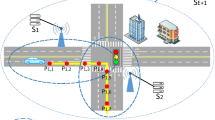Abstract
The emergence of Wireless Local Area Networks (WLANs) has brought about the possibility of mobile computing. In order to maintain connectivity to Mobile Hosts (MHs), a handover mechanism is needed as MHs migrate from one Base Station's (BS) wireless cell to another. Current handover schemes are mainly catered for connectionless WLANs (example Mobile IP) which do not have the ability to support Quality of Service (QoS) for continuous media traffic. Hence, mobility for connection-oriented WLANs (example Wireless ATM) should be considered. The problem faced in a connection-oriented WLAN is the ability to provide a fast, efficient and continuous handover mechanism. Mechanisms that can meet most of these requirements are the Incremental and Multicast Based Re-establishment handover schemes. In particular, the incremental re-establishment scheme relies on the presence of a ‘Crossover Switch’ (CX) to establish the new partial circuits to the new BS. In this paper, five CX discovery schemes are proposed to compute and select the optimised new partial path such that both the set-up latency and network resource consumption associated with the handover are small. The proposed CX discovery schemes (Loose Select, Prior Path Knowledge, Prior Path Optimal, Distributed Hunt and Backward Tracking) are suitable for wireless ATM LANs employing either the centralised or distributed connection management approach with either distance-vector or link-state-like minimumhop routing schemes. Simulation results obtained from a trace-driven mobile network simulator on four different network topologies (Random, Star, Tree and Hierarchical Redundancy) reveal that the Prior Path Knowledge and Distributed Hunt discoveries outperform the other schemes in various aspects. Finally, using the IBM PARIS Gigabit Network as an example, we show how CX discovery is incorporated with routing, connection management and QoS.
Similar content being viewed by others
References
A.S. Acampora, Wireless ATM networks,IEEE LAN/WAN Workshop (October 1993).
A.S. Acampora, Control & quality-of-service provisioning in high speed microcellular networks, IEEE Personal Commun. Mag. (Second Quarter 1994).
Bellamy,Digital Telephony (Wiley, 1982).
S. Deering, ICMP router discovery messages, IETF RFC 1256 (September 1991).
D. Waitzman, C. Partridge and S. Deering, Distance Vector Multicast Routing Protocol, Internet Network Working Group, RFC 1075 (November 1988).
M. Doar, Multicast in the ATM environment, Ph.D. Thesis, Cambridge University Computer laboratory (September 1993).
R. Earnshaw, Footprints for mobile communications,Proc. 8th IEE UK Teletraffic Symp. (April 1991).
L. Franck and B. Sales, QoS based routeing for high speed environment,Proc. 12th Int. Conf. on Computer Communications (August 1995).
Garcia-Luna-Aceves, A minimum hop routing algorithm based on distributed information, Comp. Networks & ISDN Syst. 16 (May 1989).
R. Ghai and S. Singh, A protocol for seamless communication in a picocellular network, Proc. IEEE Supercomm/ICC (May 1994).
I. Cidon, I. Gopal, M. Kaplan and S. Kutten, A distributed control architecture of high speed networks, IEEE Trans. Commun. 43(5) (1995).
K. Keeton, B. Mah, S. Seshan, R. Katz and D. Ferrari, Providing connection-oriented network services to mobile hosts,Proc. USENIX Symp. on Mobile & Location Independent Computing (August 1993).
N.-H. Lee, Routing in high speed integrated services networks, Ph.D. Thesis, Cambridge University Computer Laboratory (June 1995).
I. Leslie and D. McAuley, Fairisle: An ATM network for the local area, ACM Comp. Commun. Rev. 21(4) (1991).
J.M. McQuillan, The new routing algorithm for the ARPANET, IEEE Trans. Commun. 28(5) (1980).
P.P. Mishra and M.B. Srivastave, Call establishment and rerouting in mobile computing networks, AT& T Technical Memorandum TM-11384-940906-13 (September 1994).
J. Moy, Multicast extension to open shortest path first (MOSPF), Internet Work Group RFC 1584 (March 1994).
D.J. Nelson, An extended least-hop distributed routing algorithm, IEEE Trans. Commun. 38(4) (1990).
R. Onvural, Routing in ATM networks,Proc. TRICOMM'92: High Speed Communication Networks (February 1992).
R. Coltun, E. Hoffman, A. Mankin, R. Nair, M. Perez, M. Sosa and M. Tomaszewski, PRP: AP-NNI routing protocol proposal, ATM Forum Document, ATM-Forum/94-0492 (May 1994).
C.-K. Toh, Wireless ATM, Presentation at Queen's Mary College, University of London (July 1994).
C.-K. Toh, The design & implementation of a hybrid handover protocol for multi-media wireless LANs,ACM First Int. Conf. on Mobile Computing & Networking (MOBICOM'95) (November 1995).
W.C. Lee, M.G. Hluchyi and P.A. Humblet, Routing subject to quality of service constraints in integrated communication networks, IEEE Network Mag. (July/August 1995).
R. Want and A. Hopper, The active badge location system, ACM Trans. Inf. Syst. 10(1) (1992).
B.M. Waxman, Routing of multipoint connections, J. Select. Areas Commun. 6(9) (1988).
Author information
Authors and Affiliations
Additional information
This paper also appears in part at the IEEE INFOCOM'96, San Francisco, California, March 1996 as “Performance Evaluation of Crossover Switch Discovery Algorithms For Wireless ATM LANs”.
C-K Toh is supported by a King's College Cambridge External Research Studentship and a Cambridge Commonwealth Trust Scholarship.
Rights and permissions
About this article
Cite this article
Toh, CK. Crossover switch discovery for wireless ATM LANs. Mobile Netw Appl 1, 141–165 (1996). https://doi.org/10.1007/BF01193334
Issue Date:
DOI: https://doi.org/10.1007/BF01193334




